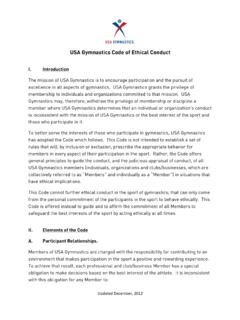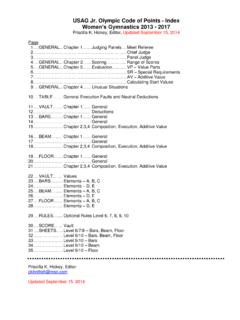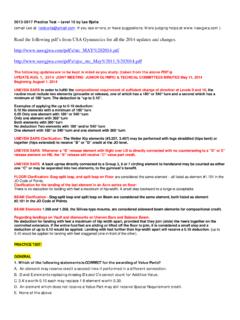Transcription of Practice Test – Level 10 - NAWGJ Wa
1 2015 Practice Test Level 9 Lee Bjella updated questions (since original 2013 test) are in red. ( if you see errors, or have suggestions. More judging helps at ) Go to USA Gymnastics for all the updates and changes. JULY 2015 UPDATES Code of Points UPDATES (revised pages and errata) Appendix 4 - Uneven Bars Symbols (revised July 2015) Appendix 5 - Beam Symbols (revised July 2015) Appendix 6 - Floor Exercise Symbols (revised July 2015) Appendix 7 - Level 9-10 Cheat Sheet (revised July 2015) Appendix 8 - Level 6-8 Cheat Sheet (revised July 2015) Appendix 11 - Level 9-10 Score Sheets (revised July 2015) Appendix 12 - Level 6-8 Score Sheets (revised July 2015) Appendix 13a - Level 8 Vault Score Sheet (revised July 2015) Appendix 13b - levels 6, 7, 9, 10 Vault Score Sheet (revised July 2015) Appendix 14 - Level 6-10 Optional Requirement Chart (revised July 2015) GENERAL 1.
2 Which of the following statements is CORRECT for the awarding of Value Parts? A. An element may receive credit a second time if performed in a different connection. B. 3 A s worth each may replace 1 B element worth C. An element which does not receive a Value Part may still receive Special Requirement credit. D. None of the above 2. What is the TOTAL MAXIMUM deduction for the following errors? - Bent knees - Legs crossed during salto - Insufficient exactness of tuck, pike or stretched position A. B. C. D. E. 3. Which of the following is applied by the Chief Judge only? A. Deducts for missing Special Requirements B. Deducts for missing Value Parts C. Awards Additive Value D. Deducts for spotting assistance during the exercise E. Deducts for missing presentation before or after exercise 4.
3 Which of the following statements is INCORRECT? A. An exercise missing one or more required Value Parts may still be awarded Additive Value. B. The Start Value of exercises on Bars, Beam and Floor is C. C elements are worth .30 each D. None of the above. 5. What is the Start Value of an exercise comprised of the following: - 5 A s, 4 B s, 0 C, 1 D - + Connection Value - Missing 1 Special Requirement A. B. C. D. 6. What is the Start Value of an exercise comprised of the following: - 3 A s, 3 B s, 1 C, 1 unallowable D - + Connection Value - No Dismount A. B. C. D. E. 7. Which of the following deductions is CORRECT? A. Legs crossed .10 B. Deviation from straight direction (UB,BB,FX) up to .10 C. Illegal placement of supplementary mats D.
4 Very large step or jump on landing E. Trunk movements on dismount landings (UB, BB) up to .30 8. Which of the following statements is CORRECT? A. Insufficient exactness of body shapes: tuck, pike, stretch up to .30 B. The same exact connection may receive Connection Value two times. C. Support on the mat with one hand deduct D. Quality of movement reflects personal style deduct up to .10 9. Which of the following is CORRECT when the bottoms of the feet do not touch first on the landing of salto elements? A. Value Part credit and Special Requirement credit are awarded, execution errors plus for the fall are deducted. B. Value Part credit, Special Requirement credit and Bonus are not awarded and is deducted for the fall. C. Special Requirement credit is awarded, Value Part credit is not awarded and is deducted for the fall.
5 D. Value Part credit is awarded, no Special requirement is awarded and is deducted for the fall. E. Value Part credit and Special Requirement credit are not awarded, execution errors plus for a large error are deducted. 10. What is the TOTAL MAXIMUM deduction for the following errors? - Spotting assistance during the exercise - Squat on landing - Extra arm swing A. B. C. D. E. VAULT 11. What is the penalty for performing a different vault than the one flashed/announced? A. B. C. D. E. No penalty 12. What is the TOTAL MAXIMUM deduction for the following errors in a Handspring 1/1 twist off vault? - Arch in 1st flight - Insufficient exactness of turn in the second flight phase - Insufficient stretch (arch) in 2nd flight - LA turn incomplete upon landing - Too long in support A.
6 B. C. D. E. 13. What is the TOTAL MAXIMUM deduction for the following faults in a Handspring on 1/1 twist off vault? - Staggered hand placement - Deviation from a straight direction - Trunk movements to maintain balance A. B. C. D. E. 14. What is the penalty if the gymnast performs a Piked Tsukahara and fails to land on the bottoms of her feet? A. B. C. D. Void vault E. None of the above 15. Which of the following would receive the LARGEST deduction? A. Brush/hit of body on the vault table in the second flight B. Touching the horse with only one hand C. 3 large steps and a fall upon landing D. Insufficient extension before landing of tuck or pike vault E. Coach standing between the board and horse on a group 3 vault 16. What is the TOTAL MAXIMUM deduction for the following faults in a Tsukahara Stretched vault?
7 - Knees bent in first flight phase - Knees bent in support phase - Legs crossed in second flight phase - Fall against apparatus upon landing A. B. C. D. E. 17. What is the TOTAL MAXIMUM deduction for the following faults? - Head touching the table in support phase - Prescribed LA turn begun too early in the repulsion phase A. B. C. D. E. 18. What is the TOTAL MAXIMUM deduction for the following faults in a Tsukahara Tuck vault? - Legs apart in first flight phase - Total absence of extension of tuck or pike A. B. C. D. E. 19. What is the TOTAL MAXIMUM deduction for the following faults in a Handspring 2/1 Twist off? - Shoulder angle in repulsion phase - One extra arm swing upon landing A. B. C. D. E. 20. Which of the following is CORRECT?
8 A. No touch of the hands on vault table B. Spotting assistance during the vault C. Coach standing between board and table on handspring vault Void D. Failure to use safety collar for round off entry vaults Void UNEVEN BARS 21. What is the TOTAL MAXIMUM deduction for the following errors? -No changes of direction in the routine -Touch on mat with feet on glide kip -Bent arms on two giant circles backwards A. B. C. D. E. 22. Which of the following is a B Value Part? A. Jump with 1/1 (360 ) to hang on HB Mount B. Jump with (180 ) turn, glide kip grip change to hang on HB Mount C. Hang on HB counterswing backward in straddle position with flight to handstand on LB. D. Clear underswing on LB, release and counter movement forward in flight to hang on HB. 23. What is the TOTAL MAXIMUM deduction for the following faults in a cast to handstand with (180 ) turn in handstand?
9 - turn completed 45 past vertical - Legs bent on cast A. B. C. D. E. 24. Which of the following is the SMALLEST deduction? A. Fail to perform both forward and backward circles and releases B. Lack of variety in choice of elements C. Hit on the mat with foot on glide kip D. Poor rhythm in elements/connections E. Under rotation of release/flight elements 25. Which of the following is a D element? A. Handstand on HB underswing with turn and flight over LB to hang on LB B. Giant circle backward to handstand with 1/1 (360 ) turn in handstand C. Handstand on HB swing down forward, back facing LB, straddle back to hang on LB D. Handstand on HB swing down between bars, swing forward to double salto backward piked dismount 26. Which of the following is an INCORRECT statement concerning Special Requirements?
10 A. Giant circle backward to handstand with hop-change to reverse grip in handstand phase is considered a flight element. B. Swing down between the bars to double salto backward tucked dismount fulfills the dismount Special Requirement. C. An exercise containing a hecht jump with legs together and hand repulsion over low bar to hang on HB (mount) and a straddle back w ith flight to handstand on LB would fulfill the 2 flight Special Requirements. D. An exercise containing only 1 bar change and 1 B flight element receives a total of .5 deduction for missing Special Requirements. 27. Which of the following is a D Value Part? A. Uprise to handstand with 1/1 turn after handstand B. Clear hip circle to handstand C. Giant circle backward to handstand with turn in handstand to mixed L grip D. L grip front giant to handstand 28.



